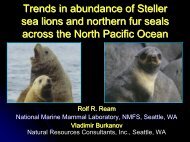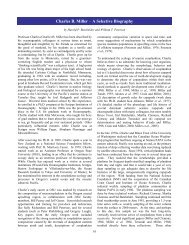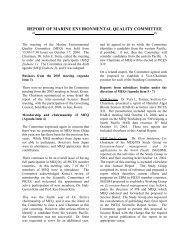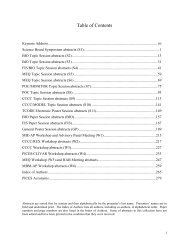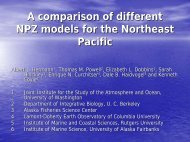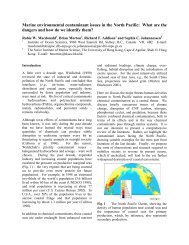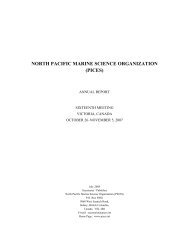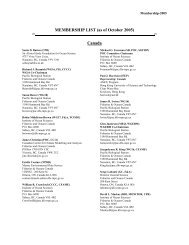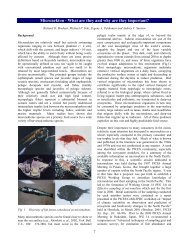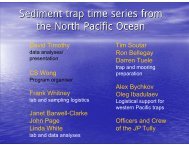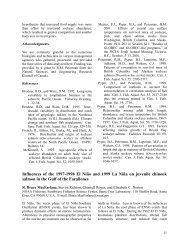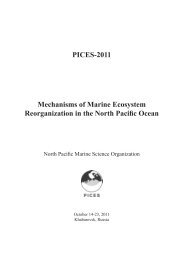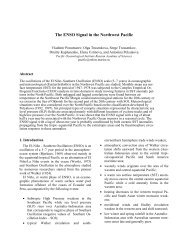The Raphidophytes – the enigmatic class! - PICES
The Raphidophytes – the enigmatic class! - PICES
The Raphidophytes – the enigmatic class! - PICES
Create successful ePaper yourself
Turn your PDF publications into a flip-book with our unique Google optimized e-Paper software.
<strong>The</strong> <strong>Raphidophytes</strong> <strong>–</strong> <strong>the</strong> <strong>enigmatic</strong> <strong>class</strong>!<br />
Carmelo R. Tomas<br />
University of North Carolina Wilmington<br />
Center for Marine Science<br />
5600 Marvin K. Moss Lane<br />
Wilmington, NC 28409 USA
<strong>Raphidophytes</strong><br />
C. marina<br />
C. antiqua C. ovata<br />
Gonoystomum<br />
Fibrocapsa.<br />
Haramonas<br />
H. akashiwo<br />
Vacuolaria
Kingdom <strong>–</strong> Chromista<br />
Infrakingdom <strong>–</strong> Heterokonta<br />
Phylum Ochrophyta<br />
Class Raphidopyceae <strong>–</strong> M. Chadefaud ex P.C. Silva 1980<br />
Orders <strong>–</strong> Raphidomonadales Norris 1982<br />
Chattonellales Throndsen 1995<br />
Systma Naturae 2000/Classification
<strong>Raphidophytes</strong><br />
Green <strong>Raphidophytes</strong><br />
Vaucheriaxanthin derivatives<br />
Freshwater<br />
Golden Brown <strong>Raphidophytes</strong><br />
Fucoxanthin dominated carotenoids<br />
Brackish/Marine<br />
Vacuolaria<br />
Heterosigma<br />
V. virescence H. akashiwo = H. carterae<br />
V. depressum<br />
Chattonella<br />
Gonyostomum<br />
C. subsalsa<br />
G. semen C. antiqua (C. harima)<br />
G. latum C. ovata<br />
C. marina<br />
Merotrichia<br />
C. globosa<br />
M. capitata C. minima a<br />
Fibrocapsa<br />
F. japonica (Chattonella japonica)<br />
Haramonas<br />
H. dimorpha<br />
H. viridis
Vacuolaria<br />
Gonyostomum<br />
Merotrichia
Toxins <strong>–</strong> reactive<br />
oxygen species,<br />
hemolytic substances,<br />
neurotoxins,<br />
ichthyotoxins and<br />
unsturated fatty acids<br />
3>25 µm long<br />
4-18 µm wide<br />
Shape <strong>–</strong> varying<br />
2 subapical heterokont<br />
flagella<br />
Chloroplasts 3 - ~ 27<br />
Forms benthic stage<br />
and cysts<br />
Accumulates in<br />
surface layers under<br />
strong light<br />
Produces allelopathic<br />
substances
Heterosigma akashiwo - What’s in a name<br />
Vulgar names <strong>–</strong><br />
Pot shard flagellate <strong>–</strong>Pratt for Narrangasett Bay<br />
Potato <strong>–</strong> morphology within a sack of potatoes -Tomas<br />
Corn Flake flagellate<br />
Pre 1980 - literature<br />
For many years mistakenly called Olsithodiscus luteus<br />
Plymouth Clone <strong>–</strong> 12A, 239<br />
Guillard Collection (WHOI) Olisth<br />
Narrangasett Bay Clones <strong>–</strong> OLMS, O. luteus
Morphology
SEM <strong>–</strong> Stazione Zoologica “A.<br />
Dohrn” di Napoli<br />
Chattonella subsalsa<br />
30-50 µm long<br />
10-30 µm wide<br />
Shape mostly pyriform<br />
Flagella 2 heterodynamic<br />
emerging subapically in<br />
depression.<br />
Chloroplasts <strong>–</strong> many, golden<br />
brown<br />
Cyst formation<br />
Toxiciy unknown <strong>–</strong><br />
Can be confused with Chattonella marina although EM features differ.<br />
Most common bloom species in coastal U.S. often associated with o<strong>the</strong>r<br />
raphidophytes.<br />
Separated from C. marina, C. antiqua and C. ovata by molecular sequences.
Chattonella subsalsa
Chattonella marina<br />
30-70 µm long<br />
20-30 µm wide<br />
2 flagella<br />
Toxins <strong>–</strong> neurotoxins<br />
ROS<br />
Hemolytic Agents
C. marina Morphology<br />
• Original Description:<br />
(Subrahmanyan) Hara & Chihara,<br />
1982<br />
• Cell size: 30-50<br />
x 20-30 µm<br />
• Shape: Oblong to ovoid with<br />
posterior protrusion.<br />
• Chloroplasts: Tightly packed<br />
• Shape and size distinguish this from<br />
o<strong>the</strong>r members of <strong>the</strong> genus.
Chattonella marina
C. marina C. subsalsa
C. antiqua Morphology<br />
• Original Description: (Hada) Ono<br />
in Ono & Takano, 1980<br />
• Cell size: 70-155<br />
x 30-50 µm<br />
• Shape: Pyriform with flat anterior<br />
portion<br />
• Chloroplasts: Tightly packed.<br />
• Largest member of <strong>the</strong> genus.
Chattonella antiqua
Cultured tuna <strong>–</strong> South Australia<br />
Yellow Tail <strong>–</strong> Seto Inland Sea,<br />
Japan
C. ovata Morphology<br />
• Original Description: Y. Hara & M.<br />
Chihara in Hara, Doi & Chihara 1994<br />
• Cell size: 50-70<br />
x 30-45 µm<br />
• Shape: Broad oval shape lacking<br />
posterior protrusion depression at<br />
anterior of cell.<br />
• Chloroplasts: Loosely Packed packed<br />
• Chloroplast shape and arrangement<br />
separates <strong>the</strong>m from o<strong>the</strong>r members<br />
of <strong>the</strong> genus.
Chattonella ovata
C. ovata C. marina<br />
C. antiqua C. subsalsa
Fibrocapsa japonica<br />
20 <strong>–</strong> 30 µm Long<br />
30 <strong>–</strong> 50 µm Wide<br />
Shape <strong>–</strong> flattened, ovate, oval or round<br />
Flagella <strong>–</strong> 2 heterokont <strong>–</strong> one long posterior<br />
and shorter anterior<br />
Emerge from anterior furrow.<br />
Mucocysts <strong>–</strong> prominent particularly in<br />
posterior of cell
Haramonas dimorpha
Heterosigma or Chattonella
Which species<br />
Does this help
So much for morphology!!!!<br />
What about pigments
Table 3. Pigment comparison of Chloromorum toxicum with o<strong>the</strong>r Xanthophyceae, Raphidophyceae and Dictyochophyceae. Pigments are in order<br />
of retention in chromatograms. All species contain Chlorophyll a and is not indicated<br />
Culture<br />
origin<br />
Chl c1+c2<br />
Chl c3<br />
Species<br />
Class<br />
Vaucheria germinata CCMP + + + + + + + + +<br />
Xanthophyceae Vaucheria bursata CCMP + + + + + + + + +<br />
Tribonema bombicina CCMP + + + + + + + + +<br />
Tribonema aequale CCMP + + + + + + + + +<br />
Green Vacuolaria virescence UTEX2237 + + + ++**<br />
Raphidophyceae Gonyostomum semens CMSTAC + + + ++**<br />
Chatonella antiqua Kagawa + + + + + + + + +<br />
Chatonella ovata Kagawa + + + + + + + + + +<br />
Chatonella marina Kagawa + + + + + + + + + +<br />
Brown Chatonella subsalsa Texas CMSTAC + + + + + + + + +<br />
Raphydophyceae Chatonella subsalsa SING CMSTAC + + + + + + + + +<br />
Chatonella subsalsa DEL CMSTAC + + + + + + + + +<br />
Chatonella subsalsa SS CMSTAC + + + + + + + + +<br />
Haramonas dimorpha CCMP + + + + + + + + + +<br />
Fibrocapsa japonica HH CMSTAC + + + + + + + +<br />
Heterosigma akaskivo Texas CMSTAC + + + + + + + + +<br />
Heterosigma akaskivo CRW CRW005 + + + + + + + + +<br />
Heterosigma akaskivo MIL Milford + + + + + + + + +<br />
Dictyocophyceae Verrucophora verruculosa Kagawa + + + + + + + + + + +<br />
Verrucophora farcimens Goebel + + + + + + + + + + +<br />
Pigment designations: + =Area % peak < 5; + + =Area % peak 5 -15; + + + =Area % peak > 15. Pigment abbreviations: Chl = Chlorophyll; Hetero<br />
= Heteroxanthin; But = 19’-butanoyloxyfucoxanthin; Fuco = Fucoxanthin; Hex = 19’-hexanoyloxyfucoxanthin; Viola = Violaxanthin; Dd =<br />
Diadinoxanthin; Morum = Morumxanthin; Diato = Diatoxanthin; Vaucher = Vaucheriaxanthin; Zea = Zeaxanthin; β, β-carotine.<br />
* Morumxanthin = 3-0-acetyl-19’-0-hexanoyl Vaucheriaxanthin;** 3-acetate 19’-decanoate Vaucheriaxanthin.<br />
Hetero<br />
19’ But<br />
Fuco<br />
19’ Hex<br />
Viola<br />
Dd<br />
Diato<br />
Morum<br />
Vaucher<br />
Zea<br />
β,β-carot
HPLC Carotenoid Pigment Comparison of three Heterosigma akashiwo clones<br />
Charleston<br />
Milford<br />
Maryland<br />
Fuco<br />
54.2<br />
Chl c1+c2<br />
11.4<br />
Fuco<br />
58.0<br />
Chl c1+c2<br />
21.2<br />
Fuco<br />
55.8<br />
Chl c1+c2<br />
21.4<br />
Viola<br />
24.0<br />
ß-car<br />
10.4<br />
ß-car<br />
7.6<br />
Viola<br />
13.2<br />
Viola<br />
13.8<br />
ß-car<br />
7.4<br />
Zea<br />
1.7<br />
Charleston<br />
Milford<br />
Maryland<br />
60<br />
60<br />
60<br />
Pigment %<br />
40<br />
Pigment %<br />
40<br />
Pigment %<br />
40<br />
20<br />
20<br />
20<br />
0<br />
c2 Fuco Viola Zea ß<br />
0<br />
c2 Fuco Viola Zea ß<br />
0<br />
c2 Fuco Viola Zea ß<br />
Pigments<br />
Pigments<br />
Pigments<br />
“green” H. akashiwo/Charleston<br />
“golden brown” Heterosigma<br />
“green” H. akashiwo/Maryland
Candy’s dandy but isn’t molecular better<br />
LSU, 18S, 16S,<br />
ITS, RCBL,<br />
Cox 1,2<br />
Molecular Troll
18s rRNA<br />
Bowers et al. 2006
16s rRNA<br />
Bowers et al. 2006
Genetic Analysis<br />
Bowers et al. 2006<br />
• “We sequenced <strong>the</strong><br />
nuclear encoded 18s<br />
locus of a panel of<br />
raphidophyte<br />
cultures…Isolates of C.<br />
antiqua, C. ovata, C.<br />
marina, and C. sp. had<br />
100% sequence<br />
similarity and shared<br />
99% similarity to <strong>the</strong> C.<br />
subsalsa isolates.”<br />
• “We partially<br />
sequenced <strong>the</strong> plastid<br />
encoded 16S locus of<br />
several<br />
raphidophyte…cultures.<br />
<strong>The</strong> members of <strong>the</strong> C.<br />
marina/antiqua/ovata/<br />
sp. complex were<br />
identical in <strong>the</strong> 16S<br />
plastid locus.”
Genetic Analysis<br />
Kamikawa et al. 2007<br />
• “When all 24 sequences were compared, a total<br />
of 16 variant sites were detected in 939 bp of<br />
cox2-coding, cox1-coding, and intergenic<br />
regions…High variation in mtDNA was revealed,<br />
and sequence analysis of <strong>the</strong> mt genome data<br />
from C. antiqua, C. marina, [and] C. ovata…<br />
demonstrated considerable intraspecific<br />
divergence among <strong>the</strong> [three] species.”
Mitochondrial Genetic Homology<br />
KAMIKAWA, R, MASUDA, I, OYAMA, K, YOSHIMATSU, S & SAKO, Y Genetic variation in mitochondrial genes<br />
and intergenic spacer region in harmful algae Chattonella species. Fisheries Science 73 (4), 871-880.
Preserved Samples <strong>–</strong> So who are <strong>the</strong>y<br />
GTA<br />
Lugols Formalin GTA<br />
Take home message!!!!<br />
Hint #1. Look at live cells!<br />
Hint #2. Culture unknown cells if possible!
Raphidophyte <strong>–</strong> imposters<br />
Olisthodiscus luteus Heterosigma akashiwo<br />
O. luteus = H. akashiwo in literature prior to 1984.<br />
Chattonella verruculosa<br />
Japan <strong>–</strong> Pseudochattonella<br />
Japan <strong>–</strong> Verrucophora verruculosa<br />
North Sea <strong>–</strong> Verrucuphora farsimens
Chattonella verruculosa Hara et Chihara<br />
(spherical form)
Chattonella aff. verruculosa <strong>–</strong> Kattegat-Skagerrak area<br />
Swedish, Norwegian Coastal Areas and North Sea<br />
Photo’s by Mats Kuylenstierna<br />
Swedish Meterological and Hydrological Institute Reports Oceanography 32<br />
Chattonella aff. verruculosa now redescribed as Verrucophora farcimen Eikrem, Edvardsen et<br />
Throndsen, gen et sp. nov.
Chattonella verruculosa <strong>–</strong> Japan<br />
Dictyocophyceae<br />
Chattonella verruculosa <strong>–</strong> New Zealand<br />
Chattonella aff. verruculosa <strong>–</strong> North Sea (Skagerrak)<br />
Chattonella cf. verruculosa <strong>–</strong> Delaware, USA (not C.v. <strong>–</strong> C. Tomas)<br />
Recent publications:<br />
Pseudochattonella verruculosa <strong>–</strong><br />
Hosoi-Tanabe, Shoko; Honda, Daiske; Fukaya, Sachiko; Otake, Isamu;<br />
Inagaki, Yuji; Sako, Yoshihiko. 2007. Phycological Research. 55:185-192(8)<br />
Verrucophora farcimens<br />
Verrucophora verruculosa<br />
B. Edvardsen, W. Eikrem, K. Shalchian-Tabrizi, I.<br />
Riisberg, G. Johansen, L. Naustvoll and J. Throndsen,<br />
2007. Journal of Phycology. 1054-1070.
Olisthodiscus luteus
Olisthodiscus luteus <strong>–</strong> not a raphidophyte.
Bald Eagle Creek, Rehoboth Bay, Delaware<br />
August 2000



